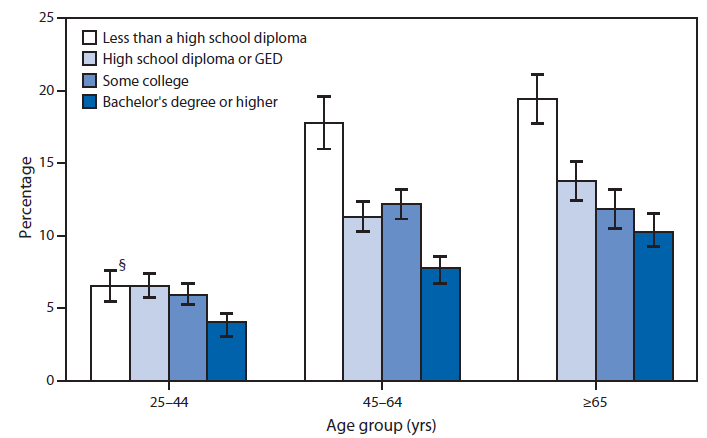QuickStats: Percentage of Adults Aged ≥25 Years with Trouble Seeing When Wearing Corrective Lenses,* by Education Level and Age Group — National Health Interview Survey, United States, 2012–2013†

Abbreviation: GED = General Educational Development certificate.
* Based on response to the question, "Do you have trouble seeing, even when wearing glasses or contact lenses?"
† Estimates are based on household interviews of a sample of the noninstitutionalized U.S. civilian population and are derived from the National Health Interview Survey sample adult component.
§ 95% confidence interval.
The percentage of adults who reported having trouble seeing when wearing corrective lenses declined with education level for all age groups. Among adults aged 25–44 years in 2012–2013, 6.6% of those who did not graduate from high school reported trouble seeing, compared with 4.1% of those who had a bachelor's degree or higher. Trouble seeing was about twice as likely for those who did not graduate from high school compared with those with a bachelor's degree or higher among adults aged 45–64 years (17.8% versus 7.8%) and aged ≥65 years (19.4% versus 10.3%). The percentage of adults aged 45–64 years and ≥65 years who reported trouble seeing was higher than the percentage for adults aged 25–44 years at every level of education.
Source: National Health Interview Survey, 2012–2013. Available at http://www.cdc.gov/nchs/nhis.htm.
Reported by: Brandy Lipton, PhD, xlw7@cdc.gov, 301-458-4318; Sandra Decker, PhD.
Alternate Text: The figure above is a bar chart showing that the percentage of adults who reported having trouble seeing when wearing corrective lenses declined with education level for all age groups. Among adults aged 25–44 years during 2012–2013, 6.6% of those who did not graduate from high school reported trouble seeing, compared with 4.1% of those who had a bachelor’s degree or higher. Trouble seeing was about twice as likely for those who did not graduate from high school compared with those with a bachelor’s degree or higher among adults aged 45–64 years (17.8% versus 7.8%) and aged ≥65 years (19.4% versus 10.3%). The percentage of adults aged 45–64 years and ≥65 years who reported trouble seeing was higher than the percentage for adults aged 25–44 years at every level of education.
Use of trade names and commercial sources is for identification only and does not imply endorsement by the U.S. Department of
Health and Human Services.
References to non-CDC sites on the Internet are
provided as a service to MMWR readers and do not constitute or imply
endorsement of these organizations or their programs by CDC or the U.S.
Department of Health and Human Services. CDC is not responsible for the content
of pages found at these sites. URL addresses listed in MMWR were current as of
the date of publication.
All MMWR HTML versions of articles are electronic conversions from typeset documents.
This conversion might result in character translation or format errors in the HTML version.
Users are referred to the electronic PDF version (http://www.cdc.gov/mmwr)
and/or the original MMWR paper copy for printable versions of official text, figures, and tables.
An original paper copy of this issue can be obtained from the Superintendent of Documents, U.S.
Government Printing Office (GPO), Washington, DC 20402-9371;
telephone: (202) 512-1800. Contact GPO for current prices.
**Questions or messages regarding errors in formatting should be addressed to
mmwrq@cdc.gov.


